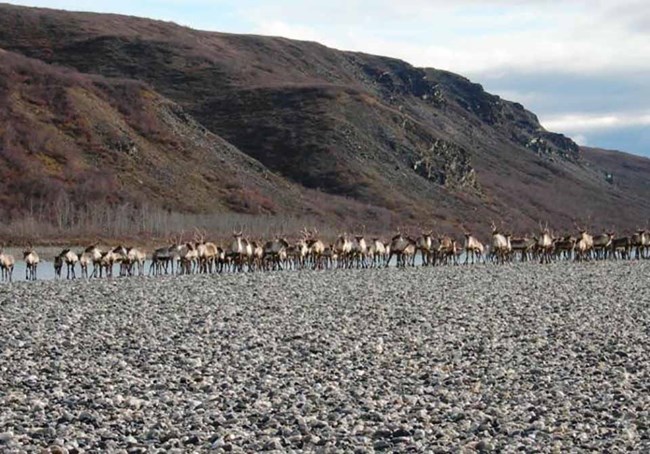Last updated: November 16, 2022
Article
Predicting Seasonal Distributions and Migratory Routes of Western Arctic Herd Caribou

Caribou are a critical subsistence resource in northwest Alaska. How close caribou come to villages affects subsistence harvests. Using eight years of GPS data from over 200 collared Western Arctic Herd caribou cows, researchers investigated what factors may influence caribou distribution and use of migratory routes. Caribou were predicted to use areas of shallower snow in winter. During the spring migration, caribou were predicted to travel along routes when the snow tends to melt out earlier or where conditions, such as greater wind, produced harder snow, which is easier to travel on. Forested habitats were avoided both on spring and fall migrations. Caribou were predicted to be closer to the coast during insect relief period probably because of the cooler temperatures and higher winds which reduce insect harassment. Caribou tended to be >20 km away from roads, villages, and other human infrastructure. Commonly used migration routes, including on the east and west side of Kobuk Valley National Park and through Cape Krusenstern National Monument, were also identified. This information could prove useful in conservation planning as a number of developments have been proposed within the herd’s range.
Using seasonal landscape models to predict space use and migratory patterns of an arctic ungulate
Abstract
Background
Caribou in the Western Arctic Herd undertake one of the longest, remaining intact migrations of terrestrial mammals in the world. They are also the most important subsistence resource for many northern rural residents, who rely on the caribou’s migratory movements to bring them near for harvest. Migratory geography has never been static, but subsistence harvesters have reported recent shifts in migration away from areas where they traditionally occurred. The reasons behind these changes are not well-understood, but may be related to rapid climate change and anthropogenic disturbances.
Methods
To predict changes in distribution and shifting migratory areas over the past decade, we used GPS telemetry data from adult females to develop predictive ecological niche models of caribou across northwestern Alaska. We employed the machine-learning algorithm, TreeNet, to analyze interactive, multivariate relationships between telemetry locations and 37 spatial environmental layers and to predict the distributions of caribou during spring, calving season, insect-harassment season, late summer, fall, and winter from 2009 to 2017. Model results were analyzed to identify regions of repeated predicted use, quantify mean longitude, predict land cover selection, and track migratory changes over time.
Results
Distribution models accurately predicted caribou at a spatially-explicit, 500-m scale. Model analyses identified migratory areas that shifted annually across the region, but which predicted 4 main areas of repeated use. Niche models were defined largely by non-linear relationships with coastally-influenced, climatic variables, especially snow-free date, potential evapo-transpiration, growing season length, proximity to sea ice, winter precipitation and fall temperature. Proximity to roads and communities were also important and we predicted caribou to generally occur more than 20–100 km from these features.
Conclusions
Western Arctic Herd caribou were predicted to occur in warmer, snow-free and treeless areas that may provide conditions conducive for efficient travel and foraging. Rapidly changing seasonal climates and coastal influences that determine forage availability, and human impediments that slow or divert movements are related to geographically and phenologically dynamic migration patterns that may periodically shift caribou away from traditional harvest areas. An enhanced understanding of the geographic behavior of caribou over time could inform traditional harvests and help conserve important Western Arctic caribou migratory areas.
Baltensperger, A. P. and K. Joly. 2019. Using seasonal landscape models to predict space use and migratory patterns of an arctic ungulate. Movement Ecology 7 (18). DOI: 10.1186/s40462-019-0162-8.
